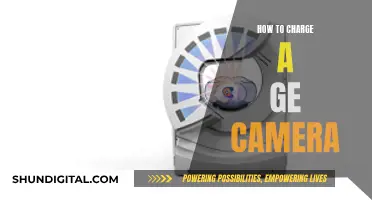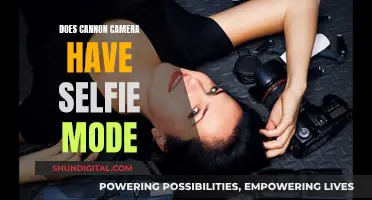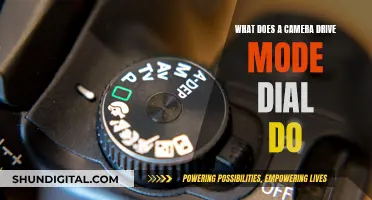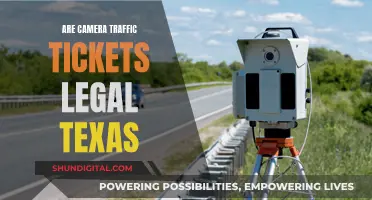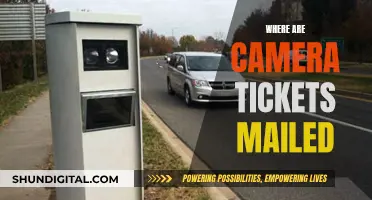
Rigging a camera to a car is a complex process that requires careful planning and execution. It is essential to prioritize safety and work with a professional grip to ensure the camera is securely mounted. Various mounting options are available, including hood mounts, side mounts, hostess trays, suction cups, and magnetic mounts, each offering unique advantages and considerations. Proper surface preparation and stabilization techniques are crucial to achieving stable and dynamic shots without causing damage to the vehicle. Additionally, legal and logistical aspects, such as obtaining permits and coordinating with local law enforcement, are vital to ensure a safe filming environment.
What You'll Learn

Suction cups and magnetic mounts
There are several options available for suction cup mounts. The RigPlate Camera Suction Mount is one of the most stable options on the market, with four suction cups providing a wide footprint and a low profile. This mount is suitable for filmmaking and cinematography, providing a solid platform for your camera. It comes in three versions: A-Cups, B-Cups, and C-Cups. A-Cups are the most general-purpose and cost-effective option, offering superb holding power. B-Cups have more holding power in a straight pull and less flex overall, but they are also more easily removed. C-Cups are designed for the most serious jobs, featuring a vacuum pump mechanism and a visual safety indicator.
When using suction cups, it is important to follow the manufacturer's instructions carefully. The surface of the car must be thoroughly cleaned before attaching the suction cups, and the cups may need to be wetted for the strongest grip. Even with proper installation, suction cups can sometimes pop off, so it is recommended to use additional safety measures such as ratchet straps to secure the unit.
Magnetic mounts, such as those offered by Oben and Rig Wheels, have a rubberized exterior to protect the mounting surface and a built-in 1/4"-20 screw for attaching accessories. These magnets are very strong and can be difficult to remove, so it is recommended to use a lever, such as a baby pin with a 1/4"-20 threaded hole, to help remove them. It is also possible to use two magnets, one on the inside and one on the outside of the car, to mount a camera on the inside of the windshield without obstructing the driver's view.
Whether you choose suction cups or magnetic mounts, always remember to "safety your gear." This means running extra ropes, ties, or cables as a backup in case your attachment method fails. Additionally, be aware that cars are not built to be camera-friendly, and there is always a chance of causing cosmetic damage to the vehicle. Take your time, follow safety precautions, and always put the safety of yourself, your crew, and bystanders first.
Editing Midtones in Camera Raw: A Step-by-Step Guide
You may want to see also

Ratchet straps and safety lines
Ratchet straps are an essential component of any camera rigging setup on a car. They provide additional security and stability to the camera, ensuring that it remains firmly attached to the vehicle during the shoot. When using ratchet straps, it is important to follow these steps for maximum safety and efficiency:
Firstly, understand that ratchet straps come in a variety of end fittings and ratchets but generally work in a similar way. They usually consist of two separate straps connected by a ratcheting assembly. When choosing a ratchet strap, consider the break strength and working load limit. The break strength of each component, including the webbing, ratchet, and end fittings, is determined through independent testing, signifying the amount of force each part can withstand before failing. The working load limit is then calculated as one-third of the break strength of the weakest component. This information is crucial for ensuring the safe use of ratchet straps.
When assembling the ratchet strap, it is advisable to pull the strap as tight as possible before starting to ratchet for maximum security. Additionally, consider using multiple ratchet straps in your setup to enhance stability. For example, when using a "hostess tray" mount, which rests on the windowsill of the car, it is common to use additional ratchet straps connected to the frame underneath the vehicle or over the roof to provide total stability. This is crucial as the "hostess tray" mount extends the width of the car, requiring ample support.
Furthermore, ratchet straps play a vital role in "safetying" your gear. This involves running extra ropes, ties, or cables to your device as a backup in case your primary attachment method fails. For instance, when using a suction cup mount, it is recommended to "safety" the rig with a ratchet strap across the hood, providing an anchor point for safety lines. These safety lines, or tethers, serve as a backup in case any part of your mounting rig fails, catching your gear and preventing it from tumbling to the ground or striking a person.
It is also important to note that ratchet straps should be used in conjunction with other safety measures. For instance, when using suction cups, ensure that the surface of the car is thoroughly cleaned beforehand to ensure a proper attachment. Additionally, follow the manufacturer's instructions on how to wet the suction cup if necessary to enhance its grip. Remember to always tie down any loose lines to avoid potential hazards.
By following these guidelines and incorporating ratchet straps into your camera rigging setup, you can ensure the safety and stability of your equipment while capturing dynamic shots on a moving vehicle.
Unlocking Camera's Potential: Expert Mode Explained
You may want to see also

Hostess tray and hood mounts
On the other hand, hood mounts are typically larger platforms that offer a wider variety of mounting positions. They are designed to be mounted on the hood but can also be placed on the roof, truck, or truck bed. These mounts often attach via plates or suction cups, and additional ratchet-style safety straps are crucial for safety. Filmmakers should always have multiple ratchet straps and know how to secure them properly.
Suction cup mounts are another option, especially for ultra-small cameras like the DJI Osmo and GoPro Hero units. These use multiple suction cups to mount the camera and are usually controlled via an app. It is important to clean the surface of the car thoroughly and follow the manufacturer's instructions for wetting the suction cup to ensure a strong grip. Even with suction cups, it is recommended to also use ratchet straps for added security.
When using any type of car mount, it is essential to consider safety. Rigging a camera to a car is more complex than it seems, and it is important to check local laws and have a professional grip on board to assist. Always "safety your gear" by running extra ropes, ties, or cables as a backup in case the attachment method fails. Additionally, do not obstruct the driver's view, and be mindful of cosmetic damage to the vehicle.
Car Cameras: Capturing the Unseen Above and Beyond
You may want to see also

Gimbal and stabilisation
Gimbals and stabilisation are essential for achieving smooth and professional-looking footage. They are particularly useful when shooting from a moving vehicle, such as a car, as they compensate for unwanted camera movement and "camera shake".
There are various types of gimbals and stabilisation systems available, from handheld gimbals to more complex, motorized stabilizers. When choosing a gimbal or stabilisation system for your car rig, there are several factors to consider:
- Type of camera: Different gimbals are designed for different types of cameras, such as mirrorless cameras, DSLR cameras, or smartphones. Make sure to choose a gimbal that is compatible with your camera.
- Weight capacity: Gimbals have a maximum load capacity, so be sure to choose one that can support the weight of your camera and any additional equipment.
- Axes of movement: Most professional gimbals offer 3-axis movement, allowing the camera to pan, tilt, and roll. However, for some applications, a 2-axis gimbal may be sufficient.
- Ease of use: Consider how easy the gimbal is to set up and operate. Look for features such as quick-release plates and intuitive controls.
- Ergonomics: Choose a gimbal with comfortable handles and good weight distribution to reduce strain on your arms and hands during long shoots.
- Additional features: Some gimbals offer advanced features such as subject tracking, tripod conversion, or remote control operation. Choose the features that best suit your needs.
- DJI RS Series: DJI offers a range of gimbals suitable for different camera types, including mirrorless and DSLR cameras. The RS 3 Mini, for example, is designed for mirrorless cameras and has a payload capacity of up to 4.4 lbs.
- Zhiyun Weebill Series: These gimbals offer features such as integrated fill lights, long battery life, and ergonomic sling structures. They are suitable for a range of camera types, including mirrorless and DSLR.
- RigWheels Cloud Mount: This is a camera vibration isolator system for handheld gimbal stabilizers. It helps to reduce strain on the gimbal's motors and bearings and can be set up quickly and easily.
- Flycam Redking: This handheld stabilizer has an aluminum frame and a quick-balance mechanism, making it easy to achieve smooth footage. It can support cameras weighing up to 5 kg.
- Glidecam XR-PRO: This stabilizer is designed for larger video cameras, with a weight capacity of up to 4.5 kg. It features a 3-axis gimbal and a telescopic central post for easy balancing.
Surveillance Camera Replacement: A-Zone's 1080p AHD Advantage
You may want to see also

Tow bars and process trailers
When rigging a camera to a car, one option available to grips is to use a tow bar or process trailer. This method involves attaching a trailer hitch adapter to the tow bar of the car, which then serves as a foundation for mounting the camera rigging setup.
The Proaim Trailer Hitch Adapter, for example, is designed to fit any vehicle with a standard 2" hitch. It uses two high-grade stainless steel 1/2" bolts to ensure a secure, zero-play connection that does not flex, vibrate, or sway. The adapter has a load capacity of 1000 kg or 2205 lb, making it strong enough to support heavy-duty camera equipment. Additionally, it offers flexible mounting options with four mounting points for speed rail pipe clamps, allowing for customisation in the angle and position of the speed rail.
Another option for camera car setups is to use a tow dolly, which can accommodate most cars up to 80" wide. The dolly has articulating wheels that allow the picture car to ride just 3" off the ground, providing a low-angle shooting option. However, it is important to note that this system may not be suitable for sports cars with low ground clearance.
Process trailers, on the other hand, can range from trucks and Hummers to high-end cars like Porsches or Mercedes. These vehicles are specially modified to accommodate camera rigs, cranes, pedestals, and/or tow dollies, depending on the specific requirements of the film shoot.
When deciding between a tow bar, process trailer, or tow dolly, it is important to consider the type of vehicle being used, the weight and size of the camera equipment, and the desired shooting angles and mobility. Each option provides a unique set of capabilities and limitations that must be evaluated to ensure a safe and effective camera rigging setup.
How to Save Camera Raw Defaults for Future Use
You may want to see also
Frequently asked questions
There are various types of car rigs available, including hood mounts, hostess trays (side mounts), car-mounted jib arms, stabilizers, and full-blown process trailers. Each setup offers different options in terms of shot selection and flexibility, and the level of involvement required from the actor.
Safety is of utmost importance when rigging a camera to a car. It is recommended to consult local laws and requirements, especially when using public roads. Working with a grip who has experience in rigging cameras to cars is highly beneficial. Always "safety your gear" by using extra ropes, ties, or cables as a backup in case the primary attachment method fails. Ensure that the rig does not obstruct the driver's view, and be cautious of potential cosmetic damage to the vehicle.
Suction cup mounts and magnetic mounts are easy to set up and serve the same purpose, but they have some differences. Magnetic mounts require a metal (iron or steel) surface, while suction cups need smooth, nonporous flat surfaces. Magnetic mounts may be preferred as suction cups can be less reliable on dirty or aged surfaces. However, suction cups can be useful for mounting cameras inside a car, such as on the windshield, by using two magnets, one on each side of the glass.
The equipment needed depends on the specific setup and requirements of the shot. Some common equipment includes camera mounting systems, suction cups, ratchet straps, gimbal stabilizers, remote camera control, camera sliders, and camera supporting equipment like dollies and jib arms.


